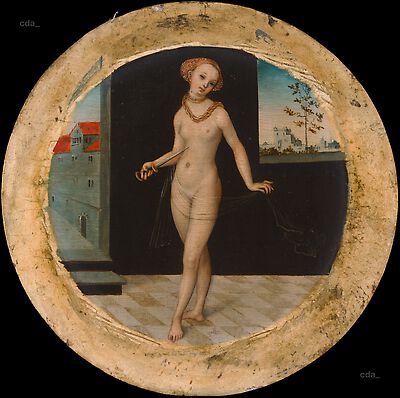The exceptional state of preservation of this panel, with all the delicate glazes for the flesh tones and the smallest details of the design preserved, allow us to admire Cranach's highly refined technique. Lucretia's long braided hair falls across her chest, while she holds a transparent gauze-like veil, which only
The exceptional state of preservation of this panel, with all the delicate glazes for the flesh tones and the smallest details of the design preserved, allow us to admire Cranach's highly refined technique. Lucretia's long braided hair falls across her chest, while she holds a transparent gauze-like veil, which only seems to accentuate her nakedness. Although they might at first seem to conflict with the erudite taste of the court of his patrons the Dukes of Saxony at Wittemberg, Cranach's nudes frequently contain an implied moral undertone. The story of the suicide of the Roman matron Lucretia, following her rape at the hands of Sextus, the son of the tyrant Tarquin, would, for example, have been quite familiar to the contemporary viewer, and such a figure would have been perceived as a Tugenwächterin or guardian of female honour and virtue. Indeed the subject of Lucretia was a favourite of Cranach's, and over sixty versions by him or his workshop are recorded.
[Sotheby's online database; http://www.sothebys.com/en/auctions/ecatalogue/2013/old-master-british-paintings-evening-l13036/lot.3.html?locale=en; accessed 20-03-2019]
- Attribution
- Lucas Cranach the Elder
Attribution
| Lucas Cranach the Elder | [Sotheby's online database; http://www.sothebys.com/en/auctions/ecatalogue/2013/old-master-british-paintings-evening-l13036/lot.3.html?locale=en; accessed 20-03-2019] |
- Production dates
- about 1525 - 1527
about 1526 - 1537
Production dates
| about 1525 - 1527 | [Sotheby's online database; http://www.sothebys.com/en/auctions/ecatalogue/2013/old-master-british-paintings-evening-l13036/lot.3.html?locale=en; accessed 20-03-2019] |
| about 1526 - 1537 | [Friedländer, Rosenberg 1979, 118, Nr. 240E] |
- Dimensions
- Dimensions of support: 14.9 cm (diameter)
Dimensions
Dimensions of support: 14.9 cm (diameter)
[Sotheby's online database; http://www.sothebys.com/en/auctions/ecatalogue/2013/old-master-british-paintings-evening-l13036/lot.3.html?locale=en; accessed 20-03-2019]
- Signature / Dating
Artist's insignia at bottom centre: winged serpent with elevated wings, facing right; in black paint
Signature / Dating
Artist's insignia at bottom centre: winged serpent with elevated wings, facing right; in black paint
[cda 2019]
- Owner
- Private Collection
- Repository
- Private Collection
- CDA ID
- PRIVATE_NONE-P253
- FR (1978) Nr.
- FR240E
- Persistent Link
- https://lucascranach.org/en/PRIVATE_NONE-P253/
